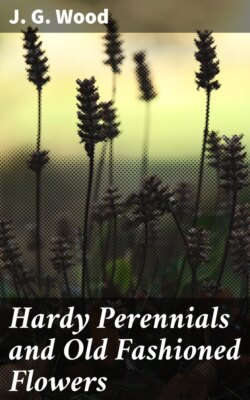Читать книгу Hardy Perennials and Old Fashioned Flowers - J. G. Wood - Страница 56
На сайте Литреса книга снята с продажи.
Cheiranthus Cheiri.
ОглавлениеTable of Contents
Common Wallflower; Nat. Ord. Cruciferæ.
Fig. 24. Chieranthus Cheiri (One-fourth natural size.)
This well-known evergreen shrub (see Fig. 24) is more or less hardy in our climate, according to the conditions under which it is grown. Although a native of the South of Europe, it rarely happens, however severe the winter may be in this country, that we are totally deprived of the favourite bouquet of Wallflowers in winter or early spring, while it is equally true that, during the hard weather of one or two recent winters, in numerous gardens every plant was killed. In favourable seasons its blooms are produced throughout winter, but the full blow comes in April. Three hundred years ago it was known by its present name; in this respect it is a rare exception, as most flowers have many and widely different names, especially the "old-fashioned" sorts, so that often the varied nomenclature hinders the identification of the species. At one time the Wallflower was called the "Gillyflower," but the name is now only applied to a biennial and single-flowered variety of the stock—a near relation of the Wallflower. More than 200 years ago Parkinson wrote, "Those Wallflowers that, carrying beautiful flowers, are the delights and ornaments of a garden of pleasure."
Of its well-known beauties, as regards its form, colour, varieties, and delicious perfume, description is needless, though I may say, in passing, that its fragrance renders it of value to those whose olfactory nerve is dead to the scent of most other flowers.
Two errors are frequently committed in planting the Wallflower; first, at the wrong time, when it is nearly a full-grown specimen and showing its flowers; next, in the wrong way, as in rows or dotted about. It should be transplanted from the seed beds when small, in summer or early autumn, and not in ones and twos, but in bold and irregular groups of scores together; anything like lines or designs seems out of harmony with this semi-wildling. There is another and very easy method which I should like to mention, as a suggestion—that of naturalisation; let those near ruins, quarries, and railway embankments and cuttings, generously scatter some seed thereon during the spring showers, when the air is still; in such dry situations this flower proves more hardy than in many gardens. Moreover, they serve to show it to advantage, either alone or in connection with other shrubs, as the whin, which flowers at the same time; here, too, it would be comparatively safe from being "grubbed up."
Flowering period, January to June.
